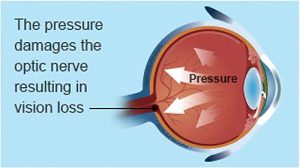
Glaucoma is a disease — really a group of diseases — that damages the optic nerve.1 High eye pressure is a risk factor for glaucoma because it can damage the optic nerve.2 When the optic nerve gets damaged over time, it has a harder and harder time doing its job, which is to transmit information to the brain. The result is permanent vision loss.3
We are also learning that retinal ganglion cells are damaged in glaucoma. These are among the many different kinds of nerve cells that are contained in the retina, a thin tissue at the back of the eye. There are over a million retinal ganglion cells that transmit light that enters the eye as information to the brain over the optic nerve. Increased intraocular pressure (IOP) has a detrimental effect.4
Learn more about intraocular pressure
The eyeball contains the jelly-like vitreous humor and the liquid aqueous humor. The aqueous humor keeps the eyeball inflated.5 The pressure it puts on the tissue is called intraocular pressure.6
This fluid normally drains into your bloodstream, but when it drains too slowly, the excess fluid increases the pressure in the eye. When the pressure becomes too great, it damages the optic nerve.7





Recent Comments